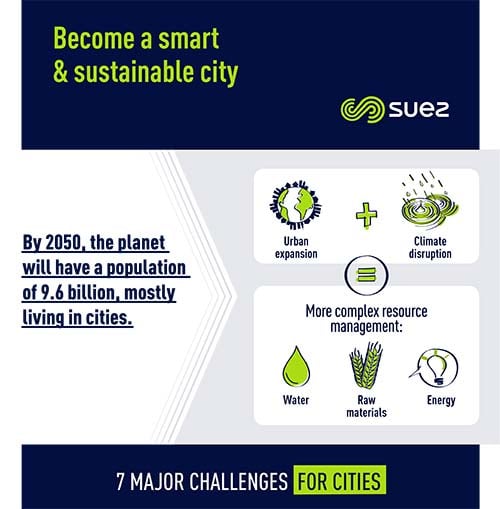Cities capable of withstanding crises and risks
Local elected officials are called upon as soon as unforeseeable events (weather-related incidents, health, social or economic crises, cyber-attacks, etc.) cause damage in their region.
How to build a more resilient city, capable of anticipating for crises and unforeseeable events, and prepared to return to a controlled situation as quickly as possible?
The Covid-19 crisis created a strong shift in which public and private decision-makers were pressured to rethink the organisation of cities for increased efficiency and a resilience capacity adapted to today’s challenges. In addition to ensuring the continuity of essential services (water supply and wastewater management, waste collection, supply of energy, transport, healthcare, etc.), the crisis highlighted the need to:
In order to achieve this, cities have to equip themselves with tools that pool information from urban services and increase management capacities during a crisis.
How to build a more resilient city, capable of anticipating for crises and unforeseeable events, and prepared to return to a controlled situation as quickly as possible?
The Covid-19 crisis created a strong shift in which public and private decision-makers were pressured to rethink the organisation of cities for increased efficiency and a resilience capacity adapted to today’s challenges. In addition to ensuring the continuity of essential services (water supply and wastewater management, waste collection, supply of energy, transport, healthcare, etc.), the crisis highlighted the need to:
- Maintain close ties between urban stakeholders - citizens, economic players, local authorities, etc.
- Break down barriers and strengthen cross-functional services within cities to allow for improved foresight, sharing of information, and coordination, as well as faster response times from all regional stakeholders.
In order to achieve this, cities have to equip themselves with tools that pool information from urban services and increase management capacities during a crisis.
The Connected Control Centre: an efficient management tool for the health crisis in Dijon
The Connected Control Centre, operating in conjunction with a hypervisor, is the backbone of the smart city project that Dijon aims to develop. It ensures the remote management of all urban equipment, traffic lights, public lighting, CCTV, etc., in the 23 municipalities of the metropolis and the coordination of the teams and operations.
On Dijon, the name given to the project launched in 2019, ensures the efficiency of public services through improved coordination, anticipation, local knowledge and speed of reaction.
On Dijon, the name given to the project launched in 2019, ensures the efficiency of public services through improved coordination, anticipation, local knowledge and speed of reaction.
The Connected Control Centre: an efficient management tool in Dijon - SUEZ
Credit: SUEZ group
The Connected Control Centre: case of a fire - SUEZ
Credit: SUEZ group
During the health crisis, the efficiency of the Connected Control Centre was proven by ensuring the rapid and effective organisation and coordination of urban facilities and services.
A toll-free number was set up before the first lockdown to help address the concerns and questions of the inhabitants concerning vital services (businesses, healthcare, etc.), to identify isolated people and to provide appropriate responses to the social difficulties encountered. OnDijon has allowed to adapt and prioritise public action to better face the crisis.
A toll-free number was set up before the first lockdown to help address the concerns and questions of the inhabitants concerning vital services (businesses, healthcare, etc.), to identify isolated people and to provide appropriate responses to the social difficulties encountered. OnDijon has allowed to adapt and prioritise public action to better face the crisis.
OnDijon made management easier during the crisis, the people gathered here learned to work together, share information and the control centre allows decisions to be taken quickerDenis Hameau
1 Ahuy, Bressey-sur-Tille, Bretenière, Chenôve, Chevigny-Saint-Sauveur, Corcelles-les-Monts, Daix, Dijon, Fénay, Flavignerot, Fontaine-lès-Dijon, Hauteville-lès-Dijon, Longvic, Magny-sur-Tille, Marsannay-la-Côte, Neuilly-Crimolois, Ouges, Perrigny-lès-Dijon, Plombières-lès-Dijon, Quetigny, Saint-Apollinaire, Sennecey-lès-Dijon, Talant
Focus on climate issues
- Global warming affects every corner of the planet and its repercussions will only increase, no matter the scenario
- The rate and intensity of extreme weather events are increasing with the rise in temperature. With a 2°C increase, a heat wave that once occurred every 50 years, would take place 14 times more often. In France, if warming of 4°C was reached, this would cause heat waves of 50°C over a section of the country
- The Mediterranean Basin, South Africa, Madagascar, Central America and Chile are included among the areas that would be the most affected by intense droughts
- In South-East Asia, annual and summer monsoon rainfall will increase throughout the 21st century, with greater fluctuations from one year to the next
- Cities will be highly exposed to climate change (heat waves, rise of sea level for coastal areas, etc.)
>> For more information on regional climate projections
Cities that limit their footprint
Cities occupy just 2% of the Earth's surface yet are responsible for 70% of CO2 emissions caused by humans. While 55% of the world’s population currently resides in urban environments, this figure is expected to reach 70% by 2050.
So, how can we make the development of cities compatible with the 2°C trajectory, while respecting the planet's physical limits? How to maintain quality of life while limiting financial pressure?
The challenges linked to the growth of these urban zones can only be addressed with an integrated global approach. It identifies action levers for cities that consume fewer resources, where the circular economy holds a crucial role.
Connected equipment combined with smart solutions allow to improve the operational performance of services (smart public lighting, optimised management of water networks, optimised waste collection routes, etc.). In addition to limiting the impact on resources (water, soil, energy, etc.) and the climate (GHG emissions), they will decrease the strain on local public funds.
Finally, the impact on environment and climate of digital solutions must fully be taken into account. Therefore, the creation of responsible digital strategies is essential to:
So, how can we make the development of cities compatible with the 2°C trajectory, while respecting the planet's physical limits? How to maintain quality of life while limiting financial pressure?
The challenges linked to the growth of these urban zones can only be addressed with an integrated global approach. It identifies action levers for cities that consume fewer resources, where the circular economy holds a crucial role.
Connected equipment combined with smart solutions allow to improve the operational performance of services (smart public lighting, optimised management of water networks, optimised waste collection routes, etc.). In addition to limiting the impact on resources (water, soil, energy, etc.) and the climate (GHG emissions), they will decrease the strain on local public funds.
Finally, the impact on environment and climate of digital solutions must fully be taken into account. Therefore, the creation of responsible digital strategies is essential to:
- Assess, in a quantitative and qualitative manner, the sector’s impact in terms of emissions, consumption of resources,
- Raise awareness among the regional stakeholders and inhabitants on the topic,
- Implement concrete actions to limit the impact of digital technologies on the region.
Cities, spaces with life
Urban nature is often reduced to its aesthetic function, yet it plays an essential role that is both environmental (maintaining biodiversity, ensuring the continuation of the water cycle, short-circuit recovery of organic waste) and economic (creating jobs and local production circuits). These living and leisure spaces promote social links and are intrinsically linked to issues of health and well-being in the city.
Urban nature also contributes to the improvement of a city’s resilience to climate disruptions (flooding, heat waves, etc.).
The Covid-19 health crisis and associated lockdown measures have accentuated this need for nature within cities, and access to green spaces has become a pressing concern for the people who live there.
So, how do we put nature back at the heart of urban projects and build solutions based on the services provided by nature, while protecting biodiversity?
Digital solutions can help strengthen the role of urban nature. By collecting field data, it is then possible to identify the need for green spaces and planning, and to facilitate their maintenance, with smart watering for example, bringing together resource preservation and monitoring of management costs.
By integrating nature in the same way as other aspects of our daily lives, smart cities make it into an essential public service for quality of life in urban areas.
The Covid-19 health crisis and associated lockdown measures have accentuated this need for nature within cities, and access to green spaces has become a pressing concern for the people who live there.
So, how do we put nature back at the heart of urban projects and build solutions based on the services provided by nature, while protecting biodiversity?
Digital solutions can help strengthen the role of urban nature. By collecting field data, it is then possible to identify the need for green spaces and planning, and to facilitate their maintenance, with smart watering for example, bringing together resource preservation and monitoring of management costs.
By integrating nature in the same way as other aspects of our daily lives, smart cities make it into an essential public service for quality of life in urban areas.
Key figures
Cities for everyone
No public or private stakeholder can address by themselves the diversity of the challenges that cities face. The city of the future must be more collaborative, and must involve all stakeholders in order to respond to its challenges in a concerted manner based on partnership.
The use of participative democracy (citizen applications, citizen platform, etc.) is growing, granting citizens a more important role in public decisions and in particular in smart regional projects. Citizens expect greater transparency from local authorities and an easier way to get involved in city initiatives (consultation on regional priorities, participation in project management, etc.).
The use of participative democracy (citizen applications, citizen platform, etc.) is growing, granting citizens a more important role in public decisions and in particular in smart regional projects. Citizens expect greater transparency from local authorities and an easier way to get involved in city initiatives (consultation on regional priorities, participation in project management, etc.).
Cities that look to the future
To prepare cities for tomorrow’s climate and the many challenges they will have to face, innovation is crucial. Whether it is technical, social or organisational, and whether it is at the scale of a building, a block, neighbourhood or a whole urban area, it allows for greater agility and responsiveness, and enables us to create services that are better suited to future ways of life. The conditions for access to innovation must be facilitated, and help local authorities to incorporate it into their projects more systematically.
Finally, innovation must generate value within the region, on a social (participative democracy, ties between inhabitants, etc.), economic (job creation, performance growth, etc.) and environmental (decrease of carbon footprint, preservation of natural resources, air quality, etc.) level.
The challenge is therefore to consolidate innovation and to turn pilots into large-scale projects to bring an adapted solution to the challenges that cities are facing.
Finally, innovation must generate value within the region, on a social (participative democracy, ties between inhabitants, etc.), economic (job creation, performance growth, etc.) and environmental (decrease of carbon footprint, preservation of natural resources, air quality, etc.) level.
The challenge is therefore to consolidate innovation and to turn pilots into large-scale projects to bring an adapted solution to the challenges that cities are facing.
Learn more

Download our infographics: "Become a smart & sustainable city"
5MB
PDF

Become a smart & sustainable city
Discover
Contact

You want some information?
Send us an email:
[email protected]
